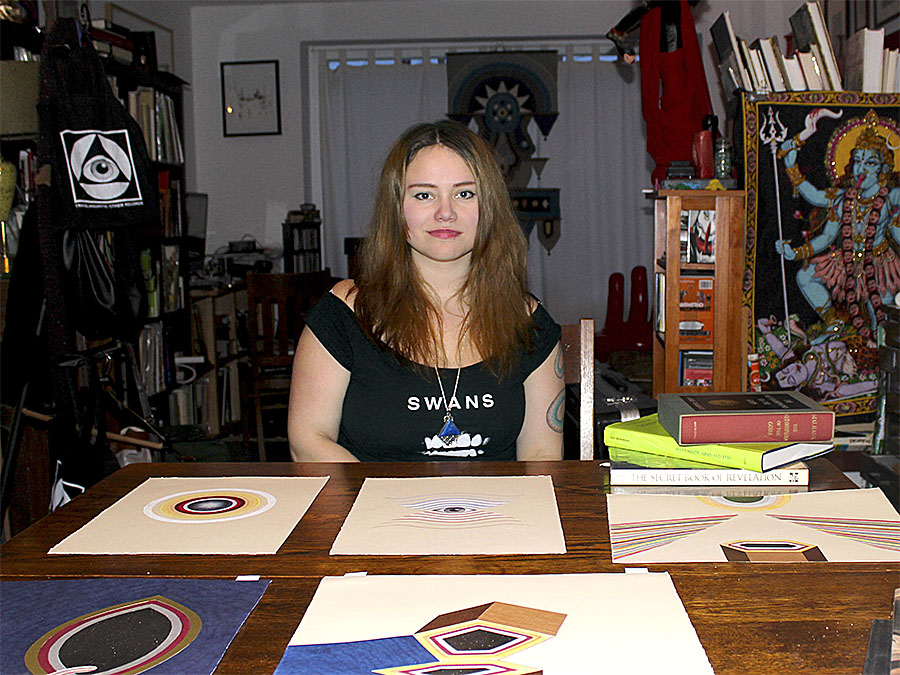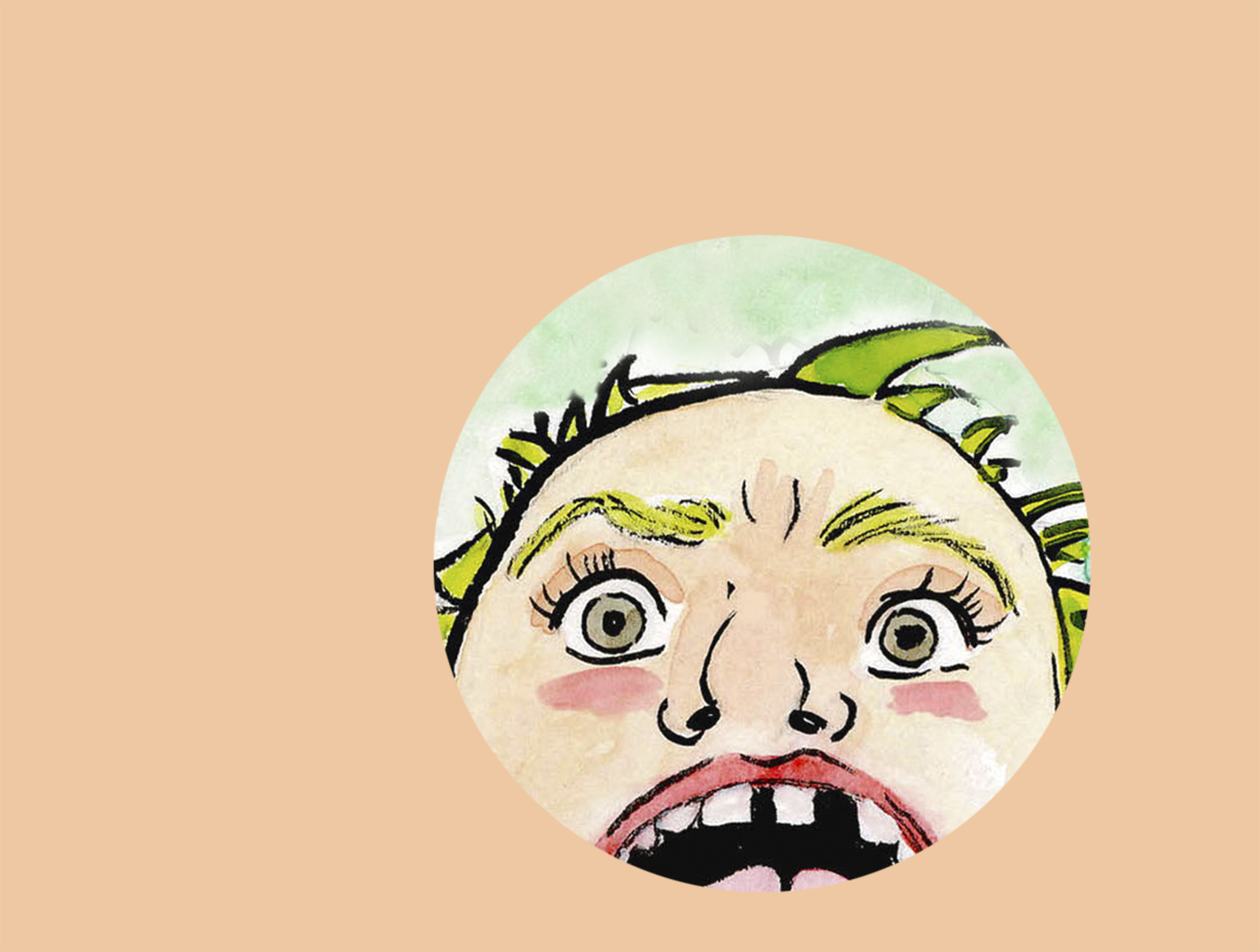My people are spread out over centuries in dusty books full of creatures with infinite eyes and many-headed serpents,” Emily Pothast tells me, handing me a dusty, thick green book. It’s titled, appropriately enough, Many Heads, Arms and Eyes.
This particular book, the first of many that Pothast will ecstatically hand me from her library during a two-hour conversation in her home, explores the “multiplicity” convention in the Vedic art traditions of India. Next comes The Secret Book of Revelation, one of her favorites, filled with esoteric, apocalyptic Christian art. She flips through the pages, stopping to point out a seven-eyed lamb sitting at the feet of Jesus, various levitating wheels covered in eyeballs, and seven-headed snakes.
“There’s the many-headed serpents in The Secret Book of Revelation, the seven-headed nagas across Buddhist and Hindu art—there’s even seven-headed serpent depictions from South America. It’s pretty ubiquitous,” she says. “When I found all these images, I found myself.”
No, Pothast doesn’t mean she self-identifies as a seven-headed serpent, although she does have a large (single-headed) snake tattooed on her arm. However, the printmaking scholar, visual artist, founder of local record label Translinguistic Other, and lead singer for psych-voyagers Midday Veil does feel a certain kinship with such fringe spiritual visionaries and artists. These intricate, rapturous representations of the infinite serve as the basis for her upcoming exhibition Drawing God From Direct Observation. Along with her own drawings, the show will feature a curated selection from her sprawling, arcane library of spiritual, religious, and ritual art books. Its intent, says Pothast, is to explore how artists throughout history have been compelled to engage with God and the infinite, driven not by religious texts or philosophical discourse but by their individual, experiential visions.
“I grew up in Iowa, Lutheran, in the middle of a farm, very isolated,” says Pothast. “At Sunday school I always had a weird relationship with the old men [singing] about Jesus. I’d always think, ‘Do you really believe this? . . . [or are you] feeling it right now when you sing?’ I’ve sung in plenty of church choirs. The question ‘Is God real?’ is meaningless when you are singing in a room full of hundreds of people doing amazing choral work. You don’t even have to call it God. It’s an activity . . . that transcends the sum of its parts. That’s what I’m interested in.” When performing with Midday Veil, Pothast claims to experience her own version of eternity, which has informed her studies in mystical art.
Pothast’s interest in such notions deepened after a car accident killed both her parents in 2005, the year she earned her MFA in printmaking at the UW. (She previously studied psychology, philosophy, and art history at Midwestern State University in Texas.) For two years, she felt like“an orphan in the void”and made little art. “I had this experience where I had to rebuild myself,” she recalls. “It was this feeling of not being connected in any way with humanity. I definitely started to identify with these people I knew about through history who had these catastrophic events in their lives and then started these visionary paths. William Blake, also a Sagittarius and a printmaker, lost his brother when he was 24 years old.”
Blake was a master of what Pothast calls “resonant forms,” visual cues that seem to suggest metaphysical activity: ovoid shapes; motion that indicates matter being devoured and reborn; a multiplicity of form that attempts to represent time. Trying to explain this latter concept, Pothast runs to the back of her Central District home to fetch a giant tapestry of the Buddhist god Yamantaka, whose countless arms are fanned out before a giant wheel of flame. Even though Blake (1757–1827) didn’t have access to Eastern art, the similarity is striking to Pothast, perhaps suggesting a deeper shared undercurrent.
She continues,“You see all these arms, and they suggest this sense of the infinite possibilities in a moment . . . all existing at once. It’s striking when you compare it to this concept of simultaneously existing parallel universes in modern theoretical physics, these ideas that Stephen Hawking believes in. I feel like these are the kinds of realities Blake was experiencing. He’s going, ‘This is the best way I know how to draw this thing I’m experiencing.’ ”
Pothast compares that ecstatic state to video feedback—a handy tool she uses in her lecture to suggest the idea of perception turned inward, a concept she believes Blake and other visionary artists have in common. With a video camera, feedback produces an infinite chain of images. When human perception feeds back, Pothast theorizes, it might not be so different.
One of the most interesting figures Pothast will discuss in her opening lecture is the relatively unknown French artist Augustin Lesage. In 1911, the 35-year-old coal miner heard otherworldly voices tell him to start painting, which he’d never done, informing him that he would be their vessel. Lesage then became a “dot-matrix printer of eternity,” in Pothast’s wonderful words, creating over 800 intricate, geometric large-scale paintings. Their intense symmetries and repetitions do suggest a kaleidoscopic feedback loop, perception turned inward on itself.
“It’s interesting that we don’t have traditions of modern ‘sacred art’ to put these artists in,” Pothast says of Lesage and company. “We have to collect them and put them in a folder called ‘visionary artists/avant-garde/psychedelic art.’ They lack a context, and while I’m aware I’m definitely not an expert, I feel like it’s part of my calling to attempt to give these artists some context in this deep trajectory of human tradition that’s been mowed down by modernity and secularism and imperialism.” E
ksears@seattleweekly.com
Hedreen Gallery Seattle University, 901 12th Ave., 296-2244, seattleu.edu. Free. 1:30–6 p.m. Wed.–Sat. Opening reception & lecture: 6 p.m. Sun., Feb. 22. Ends April 4.









